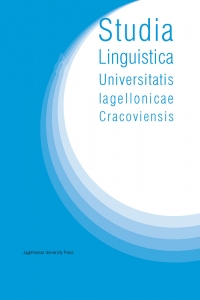Degrees of procedure activation and the german modal particles ja and doch – part 3
Degrees of procedure activation and the german modal particles ja and doch – part 3
Author(s): Christoph UngerSubject(s): Foreign languages learning, Morphology, Semantics, Philology
Published by: Wydawnictwo Uniwersytetu Jagiellońskiego
Keywords: modal particles; procedural meaning; German;
Summary/Abstract: In this paper I argue that a unitary account of the modal and non-modal uses of the German particles ja and doch can be provided by appealing to essentially non-representational properties of the theory of procedural meaning in Relevance Theory (RT). According to Wilson (2011), procedural indicators such as ja and doch function by raising the activation level of cognitive procedures, increasing the likelihood that audiences following the RT comprehension heuristic will use these procedures. Partially following proposals by König (1997) and Blass (2000, 2014), I would like to posit that ja and doch trigger a procedure to raise the epistemic strength of the proposition conveyed. Doch triggers a second procedure in addition, a constraint on context selection to the effect that the proposition conveyed must be processed in a context containing its negation. Since raising the activation level of cognitive procedures can be done in degrees, I argue that the basic difference between modal and non-modal uses of ja and doch is a reflection of differences in the degree of activation level rise: non-modal uses of ja and doch raise the activation of the manifestness procedure to a high degree, giving rise to effects such as emphasis or contrast, whereas modal uses raise this procedure’s activation level merely to some degree. As a result, modal ja and doch are uniquely suitable to mark propositions that do not need much evidential strengthening but would benefit from some such effect. This is most typically the case in mutually manifest assumptions that the communicator intends to use as premises in arguments. However, in some discourse contexts assumptions that are not mutually manifest may also fit this description. The prediction of this analysis is that the modal uses of ja and doch do not form a clearly delimited class; rather, borderline cases exist defying generalizations. I will present data from a qualitative corpus study that confirms these predictions.
Journal: Studia Linguistica Universitatis Iagellonicae Cracoviensis
- Issue Year: 133/2016
- Issue No: 1
- Page Range: 63-74
- Page Count: 12
- Language: English

